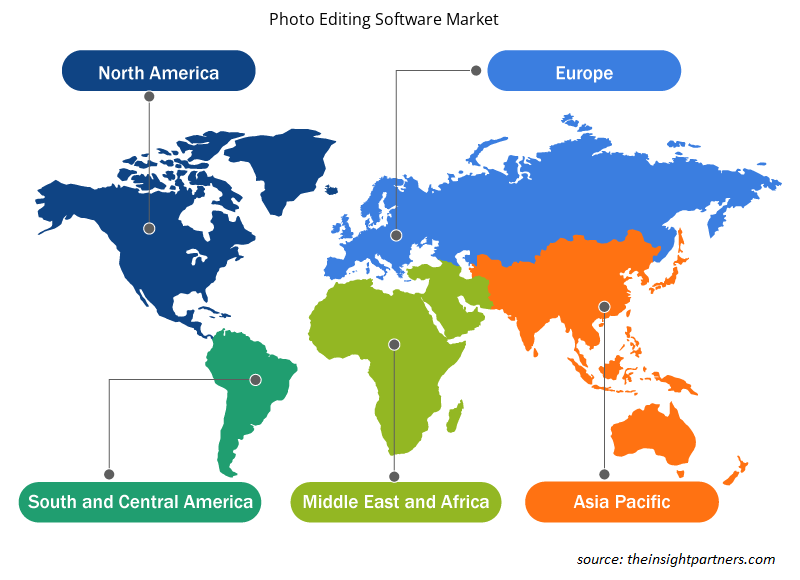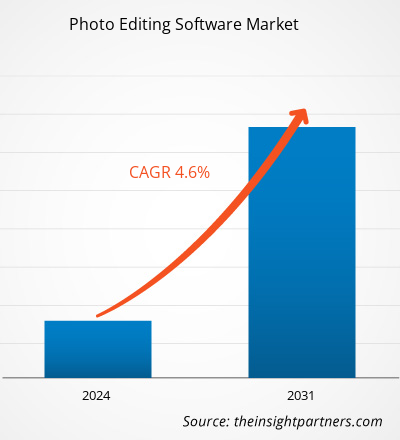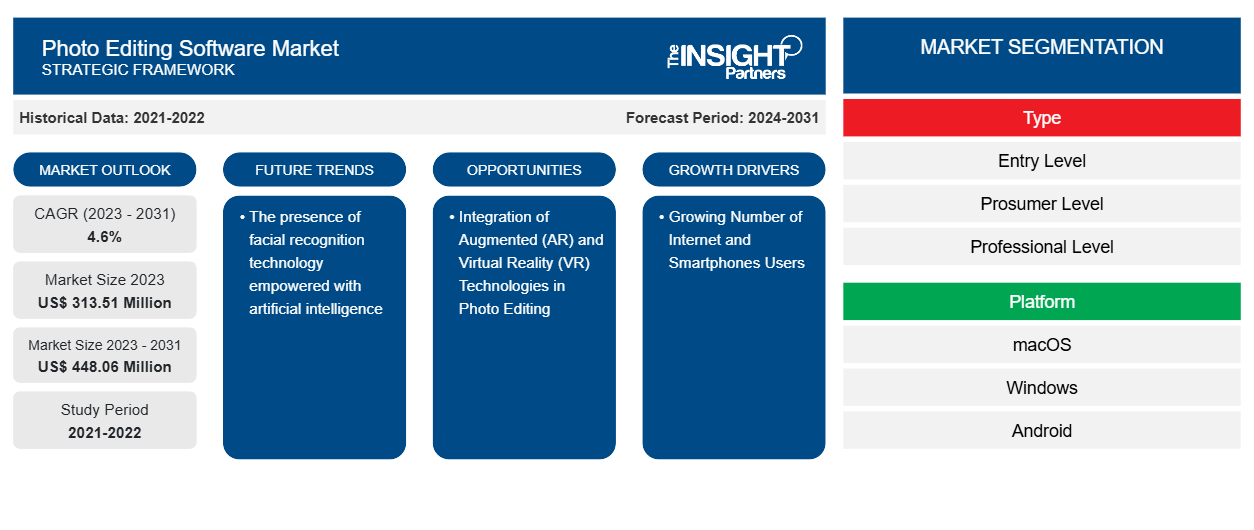Der Markt für Bildbearbeitungssoftware soll von 313,51 Millionen US-Dollar im Jahr 2023 auf 448,06 Millionen US-Dollar im Jahr 2031 anwachsen. Der Markt soll zwischen 2023 und 2031 eine durchschnittliche jährliche Wachstumsrate (CAGR) von 4,6 % verzeichnen. Die Präsenz von Gesichtserkennungstechnologie mit künstlicher Intelligenz dürfte ein wichtiger Trend auf dem Markt für Bildbearbeitungssoftware bleiben.
Marktanalyse für Bildbearbeitungssoftware
Der Markt für Bildbearbeitungssoftware wächst aufgrund der steigenden Zahl von Internet- und Smartphone-Nutzern und der steigenden Nachfrage der Verbraucher nach digitalen Fotos rasant. Der Markt wächst stetig, angetrieben durch den steigenden Bedarf an hochauflösenden Qualitätsbildern für private und kommerzielle Zwecke. Darüber hinaus bieten die Integration von Augmented-Reality-Technologien (AR) und Virtual Reality-Technologien (VR) in die Bildbearbeitung und die zunehmende Verwendung von Computeralgorithmen in Bildbearbeitungssoftware lukrative Möglichkeiten für Marktwachstum.
Marktübersicht für Bildbearbeitungssoftware
Fotobearbeitungssoftware ist eine digitale Fotoanwendung, mit der Benutzer ihre Fotos nach Bedarf zuschneiden, reparieren und organisieren können. Die Software kann gescannte Fotos von alten Filmfotografien nehmen und sie in digitale Bilder umwandeln. Diese Bilder werden weiter digital restauriert, indem Defekte entfernt und die Bildqualität verbessert werden. Die Nachfrage nach Spezialeffekten in Fotos, darunter Farbe, Farbtöne, Bildausrichtung, digitale Fotos und Ebenenbearbeitung, treibt den Markt während des gesamten Prognosezeitraums an.
Passen Sie diesen Bericht Ihren Anforderungen an
Sie erhalten kostenlose Anpassungen an jedem Bericht, einschließlich Teilen dieses Berichts oder einer Analyse auf Länderebene, eines Excel-Datenpakets sowie tolle Angebote und Rabatte für Start-ups und Universitäten.
-
Holen Sie sich die wichtigsten Markttrends aus diesem Bericht.Dieses KOSTENLOSE Beispiel umfasst eine Datenanalyse von Markttrends bis hin zu Schätzungen und Prognosen.
Treiber und Chancen auf dem Markt für Bildbearbeitungssoftware
Wachsende Zahl von Internet- und Smartphone-Nutzern treibt den Markt an
Die wachsende Internetnutzung steigert die Nachfrage nach Smartphones bei Verbrauchern auf der ganzen Welt und treibt den Markt an. Das Internet und Smartphones sind zwei der Hauptfaktoren, die den Markt antreiben. Die wachsende Zahl von Smartphone-Nutzern ist mit dem Einfluss sozialer Medien verbunden, wodurch die Nachfrage nach Bildbearbeitungssoftware bei Verbrauchern steigt. Darüber hinaus ermutigt die steigende Beliebtheit von Smartphones Marktanbieter, Bildbearbeitungssoftware zu entwickeln, die speziell für Smartphones konzipiert ist. Smartphone-Hersteller integrieren Bildbearbeitungsfunktionen auch direkt in die primäre Kamera-App, sodass Benutzer Lichtabgleich und Belichtungseffekte ihrer Fotos in Echtzeit prüfen, ändern und verwalten können. Die zunehmende Kamerafähigkeit und Verarbeitungsleistung von Smartphones veranlassen Hersteller, überlegene mobile Bildbearbeitungsanwendungen zu entwickeln, und beflügeln so die Branche.
Integration von Augmented (AR) und Virtual Reality (VR) Technologien in die Fotobearbeitung – Eine Chance auf dem Markt für FotobearbeitungssoftwareVR) Technologies in Photo Editing – An Opportunity in the Photo Editing Software Market
Die Integration von Augmented-Reality- und Virtual-Reality-Technologien in die Fotobearbeitung ermöglicht es Benutzern, realistischere Effekte auf aufgenommene Bilder anzuwenden und sie dadurch ansprechender zu gestalten. Darüber hinaus sorgt die Verwendung von AR- und VR-Technologien für ein genaues und realistisches Bild des Bildes, indem sie dessen Qualität verbessern, was die Nachfrage bei den Verbrauchern erhöht und Chancen auf dem Markt schafft. Darüber hinaus ermöglicht die Verwendung von AR-Technologie in der Fotobearbeitung Endbenutzern, realistische Effekte hinzuzufügen und gleichzeitig ein genaues und realistisches Bild zu liefern. Darüber hinaus macht das Aufkommen erfolgreicherer Tiefensensoren in Smartphone-Kameras die Einbindung von Augmented Reality in den Fotobearbeitungsprozess einfach. Somit schafft die zunehmende Einbindung von AR- und VR -Technologien in Fotobearbeitungssoftware erhebliche Wachstumschancen für den Markt.VR technologies provides an exact and realistic picture of the image by enhancing its quality, which increases the demand among consumers and creates opportunities in the market. Moreover, using AR technology in photo editing allows end users to add realistic effects while providing an accurate and realistic image. Furthermore, the advent of more successful depth sensors in smartphone cameras makes it simple to incorporate augmented reality into the photo editing process. Thus, the increasing incorporation of VR
Marktbericht zur Bildbearbeitungssoftware – Segmentierungsanalyse
Wichtige Segmente, die zur Ableitung der Marktanalyse für Bildbearbeitungssoftware beigetragen haben, sind Typ, Plattform und Endbenutzer.
- Der Markt für Bildbearbeitungssoftware ist nach Typ in Einsteiger-, Prosumer- und Profi-Level unterteilt. Das Segment der Prosumer-Level hatte im Jahr 2023 einen größeren Marktanteil.
- Auf der Grundlage der Plattform ist der Markt für Fotobearbeitungssoftware in macOS, Windows, Android und iOS unterteilt. Das Windows-Segment hatte im Jahr 2023 einen größeren Marktanteil.
- In Bezug auf die Endnutzer wird der Markt in privat und gewerblich unterteilt. Das gewerbliche Segment hatte im Jahr 2023 einen größeren Marktanteil.
Marktanteilsanalyse für Bildbearbeitungssoftware nach geografischer Lage
Der geografische Umfang des Marktberichts für Bildbearbeitungssoftware ist hauptsächlich in fünf Regionen unterteilt: Nordamerika, Asien-Pazifik, Europa, Naher Osten und Afrika sowie Südamerika/Süd- und Mittelamerika.
In Bezug auf den Umsatz hatte Nordamerika den größten Marktanteil bei Bildbearbeitungssoftware. Die Einführung von Social-Media-Werbung, die Präsenz bekannter Modemarken, der Aufstieg des Online-Werbesektors, die Expansion der E-Commerce-Branche und das Wachstum kleiner und mittelständischer Unternehmen sind wichtige Faktoren, die zum Wachstum des regionalen Marktes beigetragen haben. Die hohe Verbreitung von Internet, modernen Computern und Smartphones in den USA und Kanada hat ein günstiges Klima für das Wachstum der Video-Streaming-Branche geschaffen, was den Markt in der Region voraussichtlich ankurbeln wird.
Regionale Einblicke in den Markt für Bildbearbeitungssoftware
Die regionalen Trends und Faktoren, die den Markt für Bildbearbeitungssoftware im Prognosezeitraum beeinflussen, wurden von den Analysten von Insight Partners ausführlich erläutert. In diesem Abschnitt werden auch die Marktsegmente und die Geografie von Bildbearbeitungssoftware in Nordamerika, Europa, im asiatisch-pazifischen Raum, im Nahen Osten und Afrika sowie in Süd- und Mittelamerika erörtert.

- Holen Sie sich die regionalen Daten für den Markt für Bildbearbeitungssoftware
Umfang des Marktberichts zur Bildbearbeitungssoftware
| Berichtsattribut | Details |
|---|---|
| Marktgröße im Jahr 2023 | 313,51 Millionen US-Dollar |
| Marktgröße bis 2031 | 448,06 Millionen US-Dollar |
| Globale CAGR (2023 - 2031) | 4,6 % |
| Historische Daten | 2021-2022 |
| Prognosezeitraum | 2024–2031 |
| Abgedeckte Segmente |
Nach Typ
|
| Abgedeckte Regionen und Länder |
Nordamerika
|
| Marktführer und wichtige Unternehmensprofile |
|
Dichte der Marktteilnehmer für Bildbearbeitungssoftware: Die Auswirkungen auf die Geschäftsdynamik verstehen
Der Markt für Bildbearbeitungssoftware wächst rasant, angetrieben durch die steigende Nachfrage der Endnutzer aufgrund von Faktoren wie sich entwickelnden Verbraucherpräferenzen, technologischen Fortschritten und einem größeren Bewusstsein für die Vorteile des Produkts. Mit steigender Nachfrage erweitern Unternehmen ihr Angebot, entwickeln Innovationen, um die Bedürfnisse der Verbraucher zu erfüllen, und nutzen neue Trends, was das Marktwachstum weiter ankurbelt.
Die Marktteilnehmerdichte bezieht sich auf die Verteilung der Firmen oder Unternehmen, die in einem bestimmten Markt oder einer bestimmten Branche tätig sind. Sie gibt an, wie viele Wettbewerber (Marktteilnehmer) in einem bestimmten Marktraum im Verhältnis zu seiner Größe oder seinem gesamten Marktwert präsent sind.
Die wichtigsten Unternehmen auf dem Markt für Bildbearbeitungssoftware sind:
- ACD Systems International Inc.
- Adobe
- CyberLink Corp
- Kernunternehmen
- DXO
- INMAGINE-GRUPPE
Haftungsausschluss : Die oben aufgeführten Unternehmen sind nicht in einer bestimmten Reihenfolge aufgeführt.

- Überblick über die wichtigsten Akteure auf dem Markt für Bildbearbeitungssoftware
Neuigkeiten und aktuelle Entwicklungen zum Markt für Bildbearbeitungssoftware
Der Markt für Bildbearbeitungssoftware wird durch die Erhebung qualitativer und quantitativer Daten nach Primär- und Sekundärforschung bewertet, die wichtige Unternehmensveröffentlichungen, Verbandsdaten und Datenbanken umfasst. Im Folgenden finden Sie eine Liste der Entwicklungen auf dem Markt für Bildbearbeitungssoftware und -strategien:
- Im Februar 2024 kündigt DxO Software-Support für Canons spannendes kompaktes 10-18-mm-RF-S-Objektiv und mehr an. Die Bibliothek der DxO Optics Module umfasst jetzt Profi-Ausrüstung von Leica und Hasselblad sowie neue Objektive für Benutzer von Nikon, Sony, Fuji und L-Mount. Diese DxO Optics Module und mehr sind in den neuesten Versionen aller DxO-Fotobearbeitungssoftwareprodukte enthalten. (Quelle: DxO, Pressemitteilung, 2024)
Marktbericht zu Bildbearbeitungssoftware – Umfang und Ergebnisse
Der Bericht „Marktgröße und Prognose für Fotobearbeitungssoftware (2021–2031)“ bietet eine detaillierte Analyse des Marktes, die die folgenden Bereiche abdeckt:
- Marktgröße und Prognose auf globaler, regionaler und Länderebene für alle wichtigen Marktsegmente, die im Rahmen des Projekts abgedeckt sind
- Marktdynamik wie Treiber, Beschränkungen und wichtige Chancen
- Wichtige Zukunftstrends
- Detaillierte PEST/Porters Five Forces- und SWOT-Analyse
- Globale und regionale Marktanalyse mit wichtigen Markttrends, wichtigen Akteuren, Vorschriften und aktuellen Marktentwicklungen
- Branchenlandschaft und Wettbewerbsanalyse, einschließlich Marktkonzentration, Heatmap-Analyse, prominenten Akteuren und aktuellen Entwicklungen
- Detaillierte Firmenprofile
- Historische Analyse (2 Jahre), Basisjahr, Prognose (7 Jahre) mit CAGR
- PEST- und SWOT-Analyse
- Marktgröße Wert/Volumen – Global, Regional, Land
- Branchen- und Wettbewerbslandschaft
- Excel-Datensatz
Aktuelle Berichte
Verwandte Berichte
Erfahrungsberichte
Grund zum Kauf
- Fundierte Entscheidungsfindung
- Marktdynamik verstehen
- Wettbewerbsanalyse
- Kundeneinblicke
- Marktprognosen
- Risikominimierung
- Strategische Planung
- Investitionsbegründung
- Identifizierung neuer Märkte
- Verbesserung von Marketingstrategien
- Steigerung der Betriebseffizienz
- Anpassung an regulatorische Trends























 Kostenlose Probe anfordern für - Markt für Bildbearbeitungssoftware
Kostenlose Probe anfordern für - Markt für Bildbearbeitungssoftware